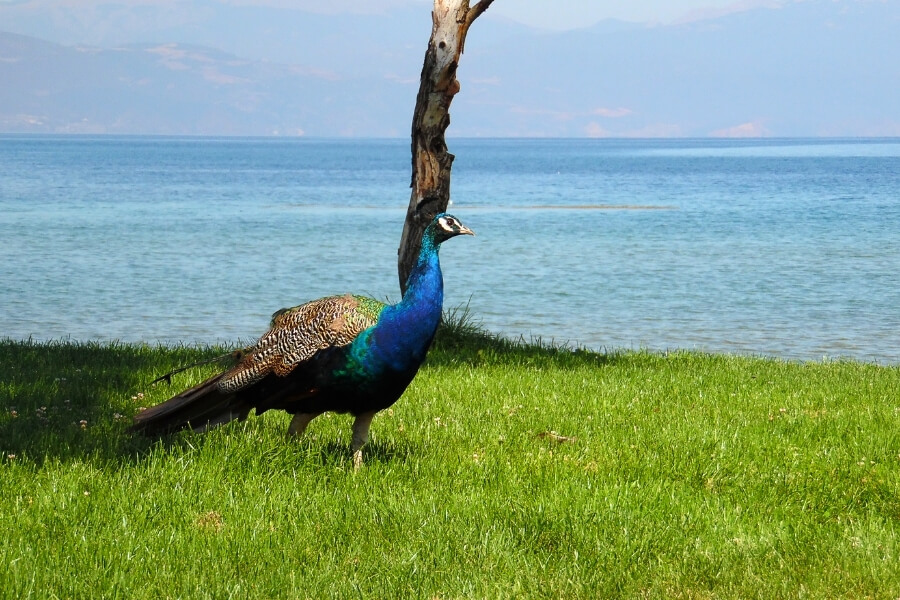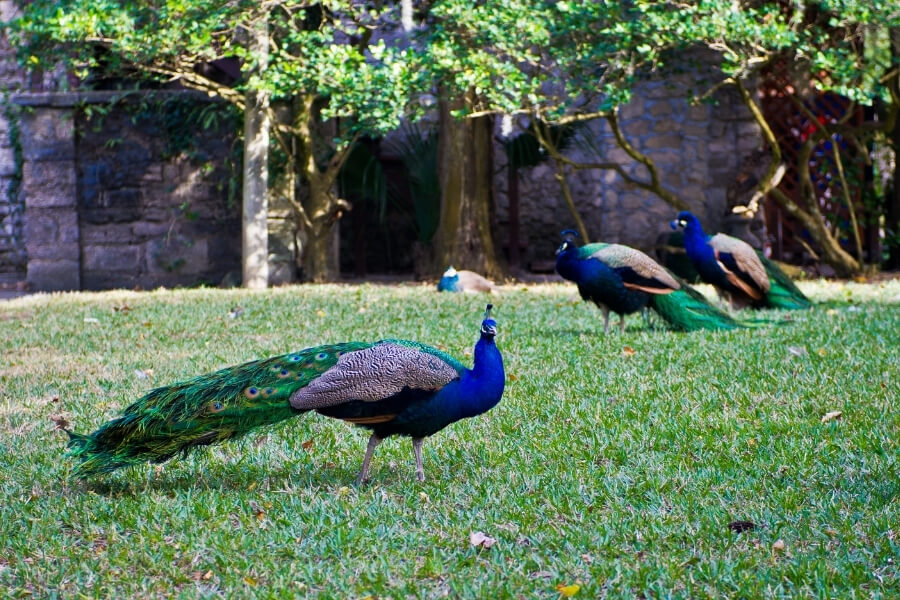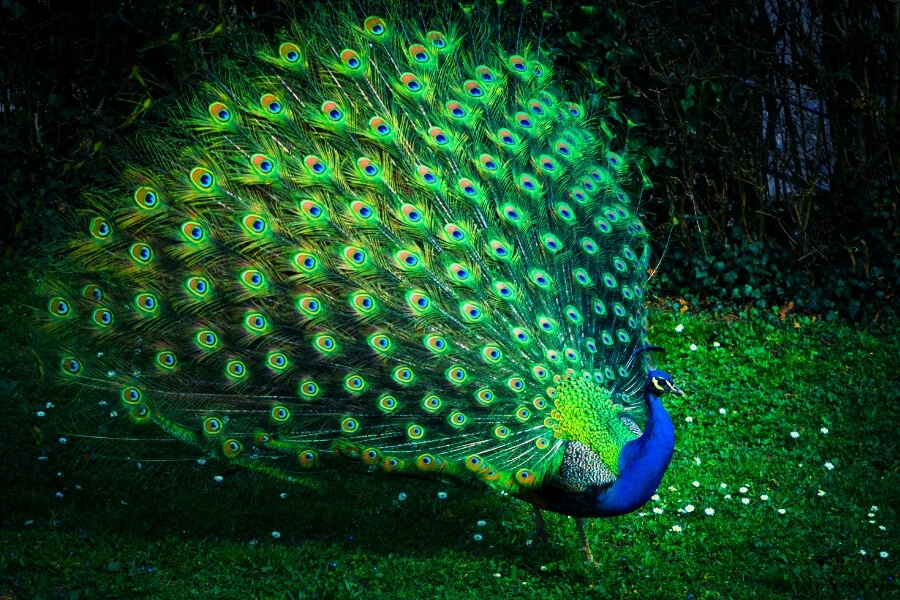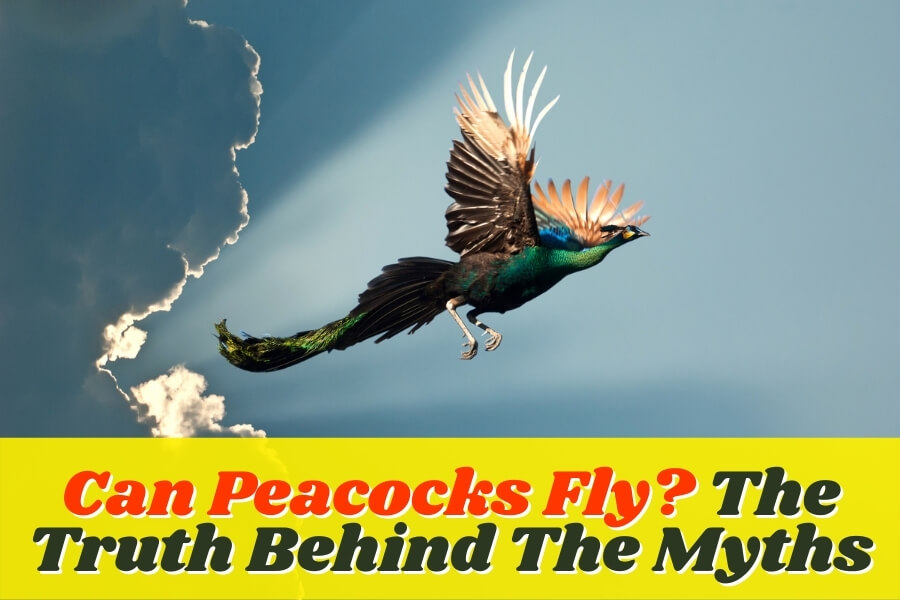So, can peacocks fly? The answer is that it depends on your definition of flying. If you define flying as taking off from the ground and soaring through the air at will, peacocks cannot do this.
However, if you define it more loosely to include things like taking short flights between trees or other perches or simply flapping their wings vigorously while jumping up into the air for a few seconds, then yes, they can fly.

And in fact, one way people have traditionally kept them captive is by clipping their train feathers. Hence, they are incapable of sustained flight but still have enough mobility to get around inside an enclosure.
Peacocks can take flight briefly by flapping their wings, but they can’t indeed fly from place to place. They can, however, use their wings to glide from place to place.
Though peacocks have been observed gliding from tree branches before, this is completely different from the sustained flight that most other birds employ.
Do Peacocks Have The Ability To Fly?
Peacocks do not have the ability to fly through the air like other birds, but peacocks can glide with the help of their peacock wings.
Peacocks can’t circulate through the air with ease as eagles and hawks do. This is because peacocks don’t have hollow bones like many bird species do, which enables them to fly quickly and efficiently through the air.

The peacock’s longest wing feathers are found on its train, which spans about two meters in length, and it is believed that peacocks use these long feathers as ‘parachutes’ so they can glide effortlessly between trees.
Why Can’t Peacocks Really Fly?
Flight can be costly in terms of energy, but if there are no predators around to force the peacocks to fly to safety, eventually, their offspring will become adapted to live on the ground.
Take turkeys as an example: wild turkeys can fly while those turkeys who’re bred for meat can’t because they have been selectively bred to weigh more and more. At this stage, they are simply too heavy to fly effectively.
Peacocks may nevertheless fly if utilized as show birds on estates or elsewhere.
How High Can Peacocks Go In The Air?
Peacocks can only hop/jump around one to two meters in the air before coming back down to earth. It is not possible for peacocks to fly high in the sky and soar around like most other birds. Peacocks can only flap their wings when they jump or take off from the ground (which is not enough to allow them to fly).

More often than not, peacocks will leap high into the sky before gliding slowly down to another tree branch or place where they want to rest or feed. Even if peacocks can’t fly like birds, they can still hop between trees with ease using their peacock wings to glide effortlessly.
How Long Can Peacocks Sustain Flight Before Going Back To Earth?
Peacocks can fly for an extended period of time, although they can only do so with the assistance of their long tail feathers.
When peacocks take flight, their tail feathers can be seen fanning out behind them. This can indicate that they can stay afloat for roughly 70 to 80 meters. In fact, peacocks will often fly in a zigzag motion at the height of about 10 meters.

The flight can last from 10 to 20 seconds, with a resting period of up to one minute before they can take flight again. However, the peacock can fly for a maximum of 1 to 2 kilometers without taking breaks.
What Are Peacock Wings Used For?
Peacocks can also use their wings to glide from place to place. However, peacock wings are not primarily used for flying.
Peacock wings are mostly used in mating rituals when peacocks spread their train feathers in order to resemble a parachute.
Male peacocks use peacock wings as a way of showing off to impress females in a display called a “train.” Female peacocks are the ones who choose their mate, so peacock wings do play a significant role in peacock mating.
How Does The Tail Of The Peacock Help It Glide From Place To Place?
Peacocks can glide across long distances using their peacock tail feathers as a type of parachute. When a peacock spreads its train feathers, it can use that into an area with an escape route.
As a peacock glides to another place, they can also use the force from the wind to give them extra lift and propulsion. One might think that this makes it easier for a peacock to fly but in fact, being so heavy is what makes it so challenging for them to get off the ground at all.

In addition, there are many downsides of gliding, such as having limited control over where you can go and no control of height or speed when going downwards. This means that while some birds can fly high and fast, others can fly low and slow. Fortunately for peacocks, they can use their long peacock tail feathers to glide and steer themselves towards a safe and suitable location where they can land.
What Do Peacocks Sound Like When They Fly?
When peacocks fly, they make a galloping noise similar to horses’ hooves.
They flap their wings in a steady rhythm rather than speeding up/slowing down. Peacocks can also make a louder “roaring” noise when they flap their wings very hard – which is usually done when attempting to take off from the ground.
If peacocks flap their wings while you’re close by, you can expect to feel a light gust of wind.
Can You Train A Peacock To Fly
If peacocks could be trained to fly, then there would be peacocks flying everywhere. The truth is that peacocks can’t fly because their long peacock tail feathers affect their ability to take flight.
If you look at a peacock’s body, it has very large, and heavy-looking breast muscles attached flat onto the chest underneath the neck. This means peacock bodies are not made for a flight like other birds (such as geese ), where their bodies are narrow and aerodynamic, allowing them to easily take off in flight.

Moreover, peacocks have short legs with small heads which are not aerodynamically suited for high-speed takeoffs or speedy trajectories when taking off in flight. In peacocks, the body weight is carried by the large peacock tail feathers, which make peacocks look very heavy. The peacock’s long peacock tail feathers are why peacocks cannot fly.
Where Are Peacocks From?
The peacock is the national animal of India. A male peafowl, also known as a peacock or Pavo cristatus, is identified by its huge, colorful tail feathers that are equal in length to the bird’s body.
Females are around half the size of their male counterparts and lack a tail, although they have a small crest on their heads.
Peacocks live in forests and open areas near wetlands but avoid very dense forests or open plains with little vegetation.
Peacocks can be found in South Asia, specifically India, Sri Lanka, Nepal, Pakistan, Bangladesh, and the Maldives.
What Are Some Misconceptions About Peacocks?
Peacock And Peahen Are The Same
A peacock is a peafowl which is a male peafowl. A peahen, on the other hand, is a female peafowl. The same thing with peacocks and sparrows are always peacocks, but sparrows can be either male or female.
Peacocks Are Exotic Birds
Peacocks are not considered exotic birds anymore since they have been introduced in other countries. Peacocks can now be found across the world, including colder climates where they can survive well. The only places peacocks don’t live are Antarctica and Iceland!
Peacocks Eat Meat
According to historians, peacocks were one of the first animals tamed by humans for food purposes. It has been recorded that people raise peacocks just for this purpose. However, peacocks are actually vegetarians who feed on seeds, fruits, and leaves.

Peacocks Are Docile And Unlikely To Harm You
Peacocks can be quite aggressive towards humans. In fact, they can cause a pretty bad injury if they peck or scratch you with their strong beaks and large claws.
They can also inflict damage by swinging their heavy tail feathers at a person who may get too close to them while mating or attempting to mate.
So keep your distance, wear thick clothing if necessary, and do not try to touch or capture them.
Other Related Questions
How Many Peacock Species Are There?
Peacocks belong to the genus Pavo of the pheasant family, Phasianidae. There are three peacock species:
- Pavo Cristatus (the Indian peacock)
- Pavo Muticus (the green peacock)
- Pavo Nigripennis (the Congo peacock)
The more common peacocks that we see in zoos, parks, and even backyards are Indian peacocks or blue peacocks.
Do Peacocks Have Teeth?
No, peacocks do not have teeth. Like other peacocks and pheasants, peacocks only have beaks that they use for feeding on seeds and leaves. The same goes for the feathers: peacock feathers don’t come from their mouths!
Do Peacocks Show Emotions?
Yes! Peacocks can show different emotions such as happiness, sadness, and anger. Some peacocks can even blush when they are happy or excited about something!
Are Peahens Good Mothers?
Peahens can be just as devoted to their eggs as hens can. Unfortunately, many eggs do not hatch because of predators such as raccoons and other animals that can easily break into nests.
One thing that peahens can do to protect their eggs is to crouch over them and make themselves look bigger than usual: this could scare away predators like foxes and coyotes.
Do Peacocks Sing?
Yes, peacocks can “sing,” but only males produce the songs we know them for. Since peacocks are polygamous, males can show peahens what they can offer by singing to them. The songs can range from harsh noises to high-pitched squawks.
Are Peacocks Monogamous?
Peacocks can be monogamous and, usually, mate for life. During mating season (spring and summer), peacocks can become quite aggressive, and it is common to see one chasing another around a yard or garden area.
In the spring, male peacocks begin to practice their “roaring,” which can sound very loud from a distance. It can be rather startling until you get used to this behavior! You can tell males from females because only the male has the iridescent neck feathers that grow outwards into a train during the breeding season.
Some people believe that if a peacock loses his train, he will not find a mate. If a peacock loses his train, he can still attract the ladies, but there is a higher chance he can lose his mate to another peacock with a larger and more attractive train.
Why Do Peacocks Like Mirrors?
Peacocks are attracted to their reflections since they don’t have many predators. Peacocks do not have to be wary about being seen by other animals. With this belief in peacocks, zoos and parks use large mirrors to keep peacocks calm and happy. This is why peacocks like mirrors: it gives them the security they need!
Conclusion
Peacocks can be very entertaining to watch as they tip-toe along the ground and then suddenly, with a burst of energy, can lift themselves into the air. They can also be quite comical as they chase each other around with one peacock flapping its wings and imitating a “roaring lion.”
They can’t literally fly but can use their large feathers to glide quite a distance.
Peacocks can also be intimidating because of their size and weight, so it is important to keep your distance and use common sense around these beautiful birds!
What do you think about them?
Thank you for reading our article, and hopefully, this can help with your research or next trip to a zoo! If we can answer any other questions about peafowl, please feel free to leave a comment below.
